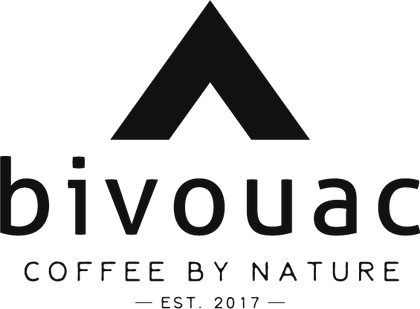Coffee might be part of your daily ritual, but how often do we stop to consider what a coffee bean actually is—and where it comes from? Before it ever reaches your grinder or your favorite brew at Bivouac, every bean takes a fascinating journey through nature, processing, and preparation. Let’s break it down.
Coffee Grows on Trees—Literally
Coffee comes from the Coffea plant, a flowering shrub or small tree native to tropical regions known as the “Coffee Belt,” which wraps around the globe between the Tropic of Cancer (23.5°N) and the Tropic of Capricorn (23.5°S). This region offers the ideal combination of temperature, altitude, and rainfall needed for optimal growing. The two most commonly cultivated species are Coffea arabica (Arabica) and Coffea canephora (Robusta).
These plants bear fruit known as coffee cherries, which look like small red or purple berries when ripe. Inside each cherry are typically two seeds—the coffee beans we eventually roast and brew. Occasionally, a cherry will contain only one small, round seed, known as a peaberry. These occur naturally in about 5–10% of cherries and are often prized for their vibrant, concentrated flavor and rarity.
From Blossom to Cherry
Once a Coffea plant reaches maturity (about 3–4 years), it produces small white flowers with a jasmine-like fragrance. After pollination, the flowers drop and green cherries begin to form. It takes 6 to 9 months for the cherries to fully ripen, depending on the variety and climate. Cherries transition from green to yellow to deep red or purple when ready to be picked.
Harvesting is done by hand or machine, depending on the terrain and scale of the farm. Once picked, the beans need to be separated from the fruit. This is where things get interesting—there are multiple methods, and each affects flavor, sustainability, and resource use.
Anatomy of the Coffee Cherry
To understand processing, it's helpful to know the layers inside a coffee cherry (see image):

Processing Methods
1. Washed Process (Wet) - Cherries are pulped by machine to remove the skin and pulp. The beans, still coated in mucilage, are fermented in water tanks for 12–72 hours to break it down. They’re then washed with large amounts of water to remove all residue. Traditional wet processing can use up to 37 gallons of water. Modern eco-pulpers significantly reduce this, but water use remains a concern in water-scarce regions.
2. Natural (Dry) Process - Cherries are spread out on drying beds or patios in the sun, turning them regularly to avoid mold. The fruit shrivels and dries around the bean over several weeks. Once fully dry, the husk is mechanically hulled to extract the beans. Natural processing is significantly more water-efficient but requires stable, dry climates and meticulous handling. Bivouac focuses mainly on naturally processed beans like in our Wild Thing, The Crux and Second Wind.
3. Honey Process (Semi-washed) - A hybrid method where the skin is removed but some or all mucilage remains during drying. It offers flavor complexity and uses less water than the washed method. We have a few varieties of the honey processed like our Honduras Single Origin and our Colombia Single Origin.
From Green Bean to Bivouac‘s Roastery
Once the beans are dried (to about 10–12% moisture content), they go through hulling to remove the parchment (if wet processed) or dried fruit layers (if natural). After hulling, the beans are graded by size, density, and quality.
They’re then bagged and exported as green coffee. Roasters receive them in this raw form and roast them according to specific profiles, unlocking the flavors we know and love. Come by our Tasting Room on Mondays to see the green bean transform into a perfectly roasted bean, ready for consumption.
What Happens to the Leftover Fruit?
The byproducts of coffee processing don’t go to waste—at least, not always. The dried skin (cascara) and pulp from coffee cherries can be dried and brewed into a tea-like beverage with notes of hibiscus, cherry, and tobacco. In washed processing, this organic matter is sometimes composted or used as fertilizer. In less sustainable operations, it can pollute waterways if not managed properly. The silverskin, a thin layer that flakes off during roasting, is added to our compost pile and sent over to the Evergreen Sustainability Alliance compost pile at Bergen Park. Learn more about how we compost in the blog Composting Coffee Grounds at Altitude.
In every cup, there’s a whole world behind the bean—from blossom to brew. Each sip carries the care of farmers, pickers, processors, and a roaster who brings it all to life. From the farm to Bivouac, we bring the wild spirit of coffee to your mug.
